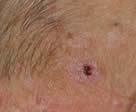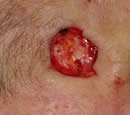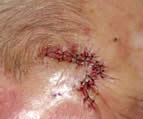|
 |
Bay Oaks Dermatology - Mohs Surgery, Vein and Laser Center in Clear Lake is a CLIA certified facility approved to perform Mohs surgery.
At Bay Oaks Dermatology, we believe in a two-fold
approach for skin cancers:
- Aggressive treatment of the skin cancer that minimizes scars.
- Prevention of future skin cancers.
  
Basal cell carcinoma removed in two Mohs stages closed via a modified rhomboid flap.
Skin Cancer is a growing epidemic that strikes one in five
Americans. If you have a spot that is changing or a sore
that won't heal, the dermatologists and physician assistants at Bay Oaks Dermatology will be pleased to examine
it, biopsy the spot if indicated and then prescribe the appropriate
treatment. Then they will provide you with the
information you need to make a sound treatment decision about your skin
cancer.
TYPES OF SKIN CANCER
- Melanoma is a potentially aggressive skin cancer that can metastasize
or spread internally if not removed quickly and completely.
People who have a family member with melanoma, have a large number of moles, have light colored eyes or light hair or have used indoor tanning machines, are at increased risk of developing melanoma. Watch out for changing moles or spots that suddenly appear.
Learn the ABCDE's of Melanoma.
- Squamous
Cell Carcinoma is developing more frequently
in Americans. This may be because of the use of immunosuppressive
drugs, such as those used in organ transplant patients.
Squamous cell carcinoma usually arises in sun damaged skin
and affects over 200,000 Americans each year.
- Basal
Cell Carcinoma is the most common cancer in America
affecting over one million Americans each year. Look for shiny,
pink bumps that grow, scar like areas that appear without
explanation or sores that won't heal. BCCs are most common
on sun exposed skin.
- Actinic
Keratoses are precancers that develop on sun
exposed skin. AKs feel rough like stickers or crusts on your
skin.
- Cryotherapy with liquid nitrogen is one way to treat AKs. Lesions may or may not blister. They usually peel and heal in 2-6 weeks. If the AK has not resolved you should return for a follow up evaluation.
- Photodynamic Therapy (PDT) with BLU-U® is way to treat precancers that cover bigger areas, such as scalp, arms, legs and face. A clear liquid medicine called Levulan® is painted on the skin and allowed to "soak in" or "incubate" for 30 minutes to 2.5 hours. The patient sits under a blue light (not ultraviolet) for about 16 minutes. "Soak in" time is increased for thicker skin. Precancer cells preferentially take up the medicine and the blue light activates it causing the cells to die. Mild to moderate stinging may be felt during BLU-U treatement. The skin is photosensitive for 40 hours after Levulan is applied. Precancers sluff off in about 1-2 weeks. Repeat treatments are usually necessary.
- Prevention of future sundamage is important. If you have had a skin cancer you should have a skin exam with a trained professional at least yearly. You should also look at your own skin at least monthly. The staff at Bay Oaks Dermatology will often recommend a regimen of sunscreens in the morning and topical
retinoids at night to help prevent new precancers. Protective clothing and hats are vital in the Texas sun. Avoiding outdoor activities in the heat of the day is smart. Daily use of multivitamins that benefit the eyes, such as PreserVision by Bausch and Lomb, may aslo benefit the skin. If you are really good at avoiding the sun you should take extra Vitamin D.
Treatment
of Skin Cancer
Dr. Shelley Sekula-Gibbs has practiced
Mohs surgery in the Houston area for over 20 years.
As a member of the American Society for Mohs Surgery and the American Society for Dermatologic Surgery she adheres
to high standards for using this successful technique including annual quality assurance testing and biannual CLIA inspection.
Mohs micrographic surgery is a specialized, highly effective technique for the removal of skin cancer. The procedure was developed in the 1950s by Dr. Frederic Mohs at the University of Wisconsin, and is now practiced throughout the world. Mohs surgery differs from other skin cancer treatments in that it requires the immediate and complete microscopic examination of the removed cancerous tissue, so that all “roots” and extensions of the cancer can be eliminated. Due to the method in which tissue is removed and examined, Mohs surgery has been recognized as the skin cancer treatment with the highest reported cure rates and smaller defects allowing for optimal cosmetic results.
Excision Surgery
Simple excision is useful for first-time skin cancer in flat areas of the body like chest, back and extremities. It can give excellent cure rates and good cosmetic results.
Curettage
and Dessication
Curettage and dessication, also called C&D, is a tried and true way to
remove non-melanoma skin cancer. Although no margins
are checked it may be quite useful for nodular or superficial
basal cell carcinoma. C&D usually results in a smooth
white scar.
Cryotherapy
Freezing with liquid nitrogen
can be useful for very small basal and squamous cell carcinomas. No margins are checked with cryotherapy so the scar must be observed closely. It may be appropriate for
certain patients.
Topical Therapy
5-Fluorouracil,
5FU (Effudex®, Fluoroplex® or Carac®)
or imiquimod (Aldara®, Zyclara®) are topical creams that can be applied to treat certain skin cancers. They cannot penetrate deeply into the skin so are often limited to flat areas of the body, like the back, chest
and arms. These medicated prescription creams are sometimes used after
surgical removal of skin cancer to reduce recurrences.
|
|





